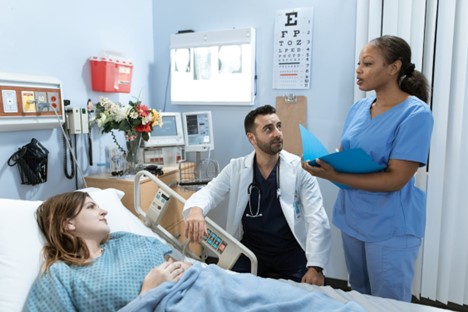Nursing students are more than just future healthcare providers; they are the key contributors to the health and well-being of their communities. Their role extends beyond the walls of hospitals and clinics, directly impacting the health of the population at large. With a unique blend of theoretical knowledge and practical skills, nursing students are instrumental in building healthier communities. This article explores ten ways these aspiring professionals contribute to public health, emphasizing their essential role in shaping a healthier, more informed, and well-cared-for society. From providing basic health services to participating in groundbreaking research, we will delve into the myriad ways nursing students are making a significant difference in the world around them.
1. Providing Basic Health Services
Nursing students are often at the forefront of providing basic but essential health services within their communities. They actively participate in community health fairs and local events, offering services like blood pressure monitoring, glucose testing, and basic health screenings. By engaging directly with the community, nursing students not only apply their learning in real-world scenarios but also foster a culture of health awareness and prevention.
2. Online Learning and Its Impact
In the digital age, many nursing students are now educated through reputable online nursing programs. These nursing school online programs offer comprehensive and flexible learning experiences that are well-suited to address the evolving healthcare challenges in communities. Students who enroll in these programs gain a wealth of knowledge and skills, enabling them to educate people effectively about maintaining health and wellness. The versatility of online education means that these future nurses can access and share the latest health information, tools, and strategies, making them well-prepared to make a significant impact in community health education.
3. Volunteering in Community Clinics
Nursing students often volunteer their time and skills in community clinics, providing invaluable support to healthcare systems that are frequently overburdened. By assisting in these clinics, they help to expand access to healthcare services. Their involvement can range from performing routine check-ups to assisting in more complex medical procedures under supervision. This not only gives them practical experience but also ensures that a wider segment of the community receives necessary medical attention, thereby enhancing overall public health.
4. Promoting Public Health Education
Public health education is a cornerstone of community wellness, and nursing students play a pivotal role in this area. They organize and participate in workshops, health seminars, and awareness campaigns, covering a range of topics from disease prevention to healthy living practices. Through these initiatives, they spread crucial information that can lead to better health choices and outcomes. By educating the public, nursing students help to prevent the spread of diseases and promote a healthier lifestyle among community members.
5. Participating in Research
Medical and health research is another key area where nursing students contribute significantly. They often engage in various research projects that aim to improve community health outcomes. This might involve collecting data, conducting surveys, or assisting in clinical trials. Their contribution to research backs the development of new treatments, health policies, and practices. By participating in research, nursing students help in advancing medical knowledge and finding solutions to public health challenges.
6. Advocating for Health Policy
Nursing students are not just future caregivers; they are budding advocates for health policy change. They play an integral role in advocating for policies that lead to better healthcare access and quality, particularly for vulnerable and less fortunate populations. Their education provides them with a deep understanding of the healthcare system, enabling them to identify areas that need reform. By participating in advocacy groups, attending public meetings, and even speaking with legislators, nursing students help shape policies that improve public health and ensure equitable access to healthcare services.
7. Addressing Mental Health Needs
Mental health is a critical component of overall well-being, and nursing students are increasingly involved in addressing this aspect in their communities. They participate in mental health awareness campaigns, assist in helplines, and support group initiatives, providing essential information and helping to destigmatize mental health issues. Their involvement often extends to educational programs where they inform the public about recognizing mental health problems, accessing care, and supporting those who are struggling. This holistic approach to health, encompassing both physical and mental aspects, is vital for building resilient communities.
8. Supporting Elderly and Vulnerable Populations
Nursing students often extend their care to some of the most vulnerable members of the community: older adults, people with disabilities, and those with chronic illnesses. They may volunteer for home health services, assist in senior centers, and provide companionship and basic care to those in need. By doing so, they help people maintain a higher quality of life and reduce their risk of hospitalization. This not only alleviates pressure on healthcare facilities but also ensures that these vulnerable groups receive the compassionate care they deserve.
9. Emergency Response and Disaster Relief
In times of crisis, whether due to natural disasters or other emergencies, nursing students are often among the first to respond. Their training prepares them to provide critical care, support, and assistance in these high-pressure situations. They may volunteer with local emergency response teams or participate in disaster relief efforts, applying their skills where they are most needed. This readiness to respond in times of crisis is an invaluable asset to any community, ensuring that help is available when it’s most crucial.
10. Promoting Health and Wellness Initiatives
Nursing students actively promote health and wellness within their communities. They initiate and participate in programs focused on physical fitness, nutrition, and overall wellness. These initiatives might include organizing community fitness events, providing nutritional counseling, or leading health education workshops. By encouraging healthy lifestyles and preventative care, nursing students help reduce the prevalence of chronic diseases and improve the general health of the community.
Conclusion
The impact of nursing students on the health of their communities is profound and multifaceted. Through their diverse roles, they contribute significantly to building healthier, more resilient communities. Their dedication and hard work not only enhance the immediate well-being of community members but also lay the groundwork for long-term public health improvements.
As nursing students transition into professional roles, the experiences they gain and the contributions they make during their educational journey continue to resonate. They not only prepare themselves for future careers in healthcare but also actively shape the health landscapes of their communities. Their commitment to the well-being of their communities is a testament to the essential role of nursing in fostering a healthier, more equitable world.
Did you find this helpful? Check out our other helpful articles on our website.
Read Also
- Automated Healthcare Software Solutions: How Intelligent Platforms Are Redefining Clinical, Administrative, and Operational ExcellenceThe healthcare industry is undergoing a seismic transformation. Rising patient volumes, value-based care models, staffing shortages, and complex regulatory demands have prompted organizations to look beyond traditional tools and embrace advanced software automation. As providers search for innovative partners capable of tailoring these sophisticated systems to real-world workflows, many turn to MCSI (Managed Care Systems,… Read more: Automated Healthcare Software Solutions: How Intelligent Platforms Are Redefining Clinical, Administrative, and Operational Excellence
- The Benefits of Contract Labor Staffing in HealthcareThe most successful healthcare facilities today aren’t just reacting to crises—they are building workforce resilience to withstand them. Unpredictable patient demand, coupled with persistent nursing shortages, has made the traditional staffing model obsolete. Relying on mandatory overtime to cover a sudden surge in capacity is a recipe for high turnover and rising employee burnout relief… Read more: The Benefits of Contract Labor Staffing in Healthcare
- Why Whole Slide Imaging Shapes the Future of Digital PathologyWhole slide imaging has become one of the most important developments in modern pathology. It changes how tissue is examined, how cases are shared and how pathologists collaborate with the wider care team. More than a technological upgrade, it represents a shift in how laboratories think about their workflow, their storage needs and the tools… Read more: Why Whole Slide Imaging Shapes the Future of Digital Pathology
- Management Reinforcement for Healthcare Providers in a Shifting SystemHealthcare is changing faster than ever. So, providers are feeling the pressure to keep up. New technology, changing patient needs, and constant rule updates make it tough for managers to stay on top. Strong leadership helps teams work better, give great care, and stay happy in their jobs. Here’s how healthcare leaders can strengthen their… Read more: Management Reinforcement for Healthcare Providers in a Shifting System
- Why Effective Disinfection Remains the Foundation of Public HealthFrom hospitals and schools to transport hubs and food production sites, disinfection is central to breaking the chain of infection and protecting community health. The COVID-19 pandemic highlighted how crucial surface hygiene and environmental control are in reducing the spread of harmful microorganisms. Yet, beyond emergency response, routine and validated disinfection practices remain the cornerstone… Read more: Why Effective Disinfection Remains the Foundation of Public Health
- How to Navigate Your Medical Assistant Career PathBecoming a medical assistant can feel both exciting and a little stressful. This job lets you work closely with doctors and other healthcare workers to help patients. But with so many different paths to take, it can be hard to know where to start or how to plan your career. Wouldn’t it be nice to… Read more: How to Navigate Your Medical Assistant Career Path
- Benefits of Enrolling in Botox Training CoursesMany people want to enhance their skills in the beauty field, and one way to do that is through Botox training. With the rising popularity of Botox, enrolling in training courses can set you on a path to a rewarding career. If you are considering this option, you might be curious about the benefits that… Read more: Benefits of Enrolling in Botox Training Courses
- Comparing 2025 Dental Practice Management Software OptionsSoftware Key Strengths Potential Limitations Best For Dentimax • Offers both cloud-based and on-premise/server deployment. • Tight integration between imaging (e.g. X-ray sensors) and practice management, charts, treatment planning, imaging all in one. • Transparent pricing and relatively simple UI/usability; solid for small to medium general practices. • May lack some of the… Read more: Comparing 2025 Dental Practice Management Software Options









